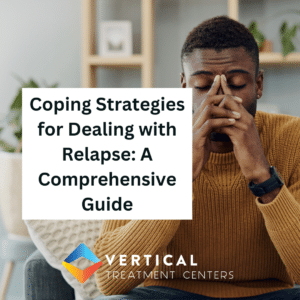
Coping Strategies for Dealing with Relapse: A Comprehensive Guide
Recovering from addiction is an arduous journey often marked by episodes of relapse. This post serves as a compassionate guide to provide you with powerful and actionable strategies to navigate relapses along the way.
II. Understanding Relapse
Relapse in addiction recovery refers to a temporary slip or return to a previous behavior that we’re trying to control or quit. A crucial thing to grasp is that relapses are not an indication of failure but an indication that our current method of recovery may need adjustment
III. Recognize the Signs of Relapse
Before a physical relapse occurs, there are usually warning signs. These can include emotional distress, social withdrawal, or escalating internal conflict. Recognizing and responding to these early signs can forewarn a possible relapse, creating an opportunity for proactive prevention.
IV. Mental and Emotional Wellness Maintenance
Maintaining mental and emotional wellness is critical in enduring recovery. Practices such as mindfulness, meditation, yoga, and regular exercise can help manage stress and lower the risk of relapse. If you don’t already have a self-care routine, consider incorporating these practices.
V. Effective Communication about Relapse
Speaking openly about the fears and realities of relapse can provide a sense of relief. Communication should be honest, open, and non-judgmental. Support networks, including family, sobriety groups, or therapists, can provide valuable emotional support during these conversations.
VI. Coping Strategies: Personal
Practicing personal coping strategies is a powerful tool in preventing relapses. Here are a few effective tactics:
- Engaging in physical activity: Exercise releases endorphins, which are the body’s natural mood lifters.
- Journaling: Writing can be a therapeutic outlet for emotions.
- Stay in tune with your emotions: Recognizing and validating your emotions can prevent them from building and causing distress.
- Pursuing a hobby: An engaging hobby can distract you from cravings and negative emotions.
VII. Coping Strategies: Professional
Seeking professional help during a relapse can be a game changer. This can include therapy (individual or group), medication, or adjustments to your existing treatment plan. Behavioral therapies like Cognitive Behavioral Therapy (CBT) can equip you with practical skills to deal with stressors and triggers effectively.
VIII. Manage Triggers and High-Risk Situations
It’s essential to identify and understand your triggers—people, places, or situations that ignite intense cravings. Have a plan to manage these triggers, whether it involves avoiding them, employing stress-reduction techniques, or reaching out to your support system in times of vulnerability.
IX. Importance of Routine and Structure
Routines offer a sense of normalcy and security. You can create stability and reduce the potential for relapse by maintaining a regular sleep schedule, eating healthy food at regular intervals, scheduling time for leisure activities and self-care, and sticking to a structured recovery program.
X. Staying Committed to Recovery
Even during relapse, hold fast to your commitment to recovery. Remember that recovery is not a linear path—it is a journey with its peaks and valleys. The key is to keep going, stay committed, and seek motivation, whether from peer stories, inspirational resources, or your own personal goals.
XI. Conclusion
Relapse is a common, anticipated, and manageable part of the recovery process. Instead of viewing it as a failure, see it as a learning experience—an opportunity to reassess and adjust your recovery plan. Practice self-compassion, maintain open communication, and don’t hesitate to seek professional help. You are not alone on this journey, and with these strategies in hand, you can navigate the seemingly tough times more effectively.